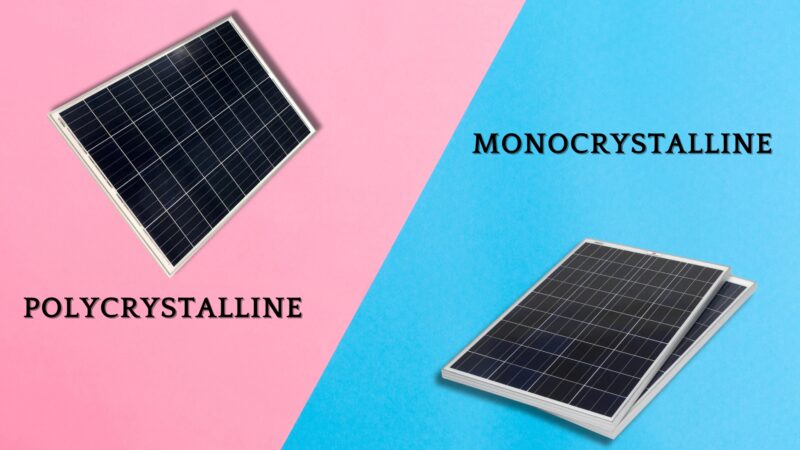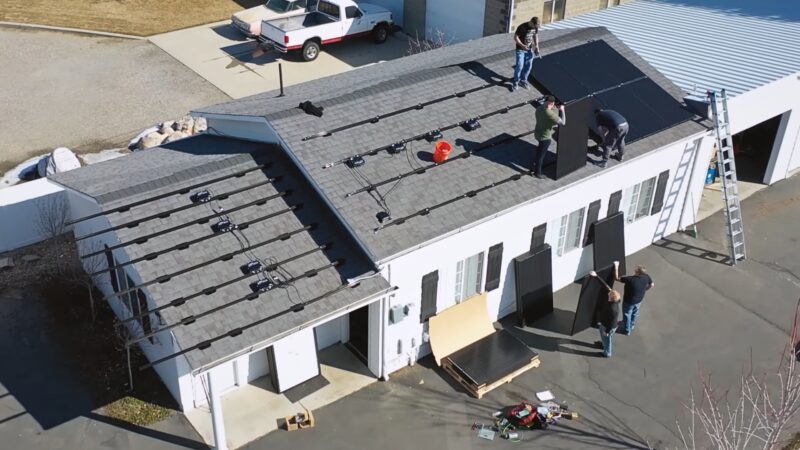Solar power has revolutionized the way we perceive and utilize energy. The ability to use it as a resource to generate energy can significantly reduce our carbon footprint and electricity bills. But how does this technology work, and what do you need to know before installing it on your roof?
Basics
Solar panels, also known as photovoltaic (PV) panels, convert sunlight into electricity. This transformation occurs through a fascinating process where photons from the sunlight knock electrons free from atoms, generating a flow of electricity.
The inception of solar power dates back to the 19th century, but it’s the continuous advancements in technology that have made it a viable energy source today. The efficiency, cost-effectiveness, and environmental benefits of solar panels have propelled them into the limelight, becoming a pivotal player in the global shift towards sustainable energy.
Types of Solar Panels

When considering installing solar panels, it’s imperative to understand the different types available and how they might suit your specific needs and environment. Monocrystalline, polycrystalline, and thin-film solar panels dominate the market, each with their unique attributes and efficiencies.
Monocrystalline panels are renowned for their efficiency and sleek design, while polycrystalline panels offer a balance between cost and performance. On the other hand, thin-film panels are versatile and lightweight, albeit with a lower efficiency.
Understanding the distinctions between these types of panels will enable you to make an informed decision, aligning your choice with your energy needs, budget, and available space.
Pre-Installation Considerations
Before starting with the installation process, there are several factors to consider. From assessing your roof’s suitability to understanding the financial aspects, these initial steps are crucial in ensuring a smooth and successful installation process.
The Roof Must be Suitable
- Angle and Orientation: Ideal for capturing maximum sunlight.
- Size and Shape: Ensuring ample space for the panels.
- Condition: A sturdy and healthy roof is paramount.
The orientation, material, and condition of your roof are essential in determining the efficiency of your solar panels. A south-facing roof is often considered ideal in the northern hemisphere for optimal sunlight exposure.
Additionally, the structural integrity and material of your roof should be conducive to supporting the weight and structure of the panels.
Financial and Legal Aspects

- Budget: Understanding and allocating finances.
- Incentives: Exploring governmental and local incentives.
- Regulations: Adhering to local laws and guidelines.
Navigating through the financial and legal aspects of solar panel installation can be intricate. Establishing a budget is the initial step, followed by exploring various financing options, subsidies, and incentives offered by the government and local authorities.
Besides that, adhering to the zoning laws, obtaining necessary permits, and ensuring that the installation abides by local and national regulations is crucial.
The EnergySage provided a detailed research related to the price of the installation:
“The average cost of a solar panel installation in 2023 ranges from $17,430 to $23,870 after taking into account the federal solar tax credit, with an average solar installation costing about $20,650. On a cost per watt ($/W) basis, solar panel prices in 2023 average $2.95/W (before incentives).
This data comes from our own marketplace data from thousands of users across 37 states and Washington D.C.”
The Installation Process
Installing solar panels is a meticulous process that involves several stages, each crucial in ensuring the efficiency and safety of the system. From selecting a reliable installer to understanding the installation mechanics, each step plays a pivotal role in your solar energy journey.
Choosing a Reliable Installer
Selecting a proficient and reliable installer is the cornerstone of a successful solar panel installation. This involves researching and comparing various companies, scrutinizing their reviews, credentials, and experience.
It depends on your location as well. For example, states like Kansas, Nebraska, and Colorado are known for having reliable companies that you can hire. Your chosen installer should not only exhibit profound knowledge and experience but also demonstrate a commitment to quality and customer satisfaction.
Engaging with previous clients, exploring their portfolio, and understanding their approach towards safety and quality assurance will provide insight into their modus operandi.
The Mechanics of Installation
Understanding the mechanics of installation can empower you to be actively involved in the process, ensuring that every step is executed with precision and care. The installation process commences with setting up the mounting system, followed by installing the solar panels, and finally, connecting them to an inverter.
The inverter plays a crucial role in converting the direct current (DC) produced by the panels into alternating current (AC), which is utilized in your home.
Maintenance and Monitoring
Once your solar panels are up and running, the journey doesn’t end there. Ensuring that they operate at peak efficiency requires regular maintenance and monitoring. Let’s delve into the nuances of keeping your solar system in top shape.
Routine Maintenance
Solar panels are relatively low-maintenance, but like any other equipment, they benefit from regular check-ups.
- Cleaning: Dust, debris, and bird droppings can accumulate on the panels, reducing their efficiency. It’s essential to clean them periodically, especially in areas with less rainfall which might naturally clean them.
- Inspections: While solar panels are durable, it’s a good practice to inspect them for any potential damages, especially after extreme weather conditions.
- Professional Check-ups: Engaging with professionals for an annual inspection can be beneficial. They can check the entire system, including the inverter, cables, and mounts, ensuring everything is functioning optimally.
Monitoring System Performance
Modern solar installations often come with monitoring systems that provide real-time data on the performance of your solar panels.
- Real-time Data: These systems allow you to track the amount of electricity your panels are producing and how much you’re consuming, giving you insights into your energy habits.
- Troubleshooting: If there’s a drop in efficiency or any other issue, the monitoring system can alert you, enabling timely interventions.
- Optimizing Usage: By understanding your energy production and consumption patterns, you can make informed decisions, such as using energy-intensive appliances during peak production hours.
The Environmental and Financial Benefits

Transitioning to solar energy is not just about harnessing the sun’s power; it’s also about understanding the profound impact it has on the environment and your finances.
The Green Impact
Solar energy is one of the cleanest sources of energy, significantly reducing the carbon footprint of households.
- Reducing Carbon Emissions: Traditional electricity sources, especially those relying on fossil fuels, emit a significant amount of greenhouse gases. Solar panels, on the other hand, produce clean energy, contributing to a substantial reduction in carbon emissions.
- Conserving Resources: Solar energy reduces the reliance on finite natural resources, ensuring a sustainable energy future.
Financial Savings
While the initial investment might seem substantial, the long-term financial benefits of solar panels are undeniable.
- Reduced Electricity Bills: Once the solar panels are operational, you can witness a significant reduction in your electricity bills, often generating surplus energy which can be fed back into the grid in some regions.
- Tax Credits and Incentives: Many governments offer tax credits, rebates, and incentives for transitioning to solar energy, further reducing the overall cost of installation.
- Increased Property Value: Homes equipped with solar panels often have a higher market value, making it a sound investment for the future.
FAQs
How do solar panels perform in areas with limited sunlight?
Solar panels can still generate electricity in areas with limited sunlight, but their efficiency might be reduced. Modern solar panels are designed to capture and convert even diffused sunlight.
However, in regions with prolonged cloudy or rainy seasons, it’s essential to consider the reduced energy output when calculating potential savings and return on investment.
Can I sell excess energy back to the grid?
Many regions offer net metering, allowing homeowners to sell excess energy generated by their solar panels back to the grid. This can offset electricity bills or even result in a credit. However, policies vary by state and utility company, so it’s crucial to check local regulations and agreements.
What happens to solar panels at the end of their lifespan?
Solar panels typically have a lifespan of 25-30 years. While their efficiency might decrease over time, they can still produce energy beyond this period.
When they reach the end of their effective life, many components of the panels, including glass, metals, and wiring, can be recycled. Some manufacturers also offer take-back and recycling programs.
Are there any insurance considerations when installing solar panels on my roof?
Installing solar panels can increase the value of your home, so it’s essential to inform your home insurance provider about the addition. Some providers might adjust premiums based on the perceived risk or value increase.
It’s also a good idea to ensure that the panels are covered against potential damages like storms or fires.
Summary
The declining cost of solar panels, combined with the various incentives available, makes solar energy an attractive option for homeowners. By understanding the factors that influence the cost and the potential savings, individuals can make informed decisions about transitioning to renewable energy sources.
